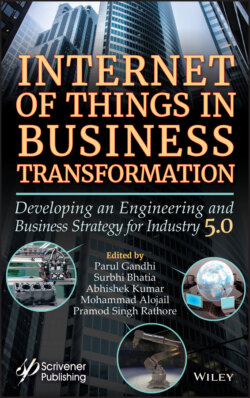Читать книгу Internet of Things in Business Transformation - Группа авторов - Страница 24
2.1 Introduction
ОглавлениеInternet of Things (IoT) is the inter-communication of various sensors and embedded systems, without human to human interaction and human to sensor interaction, via the internet and its ability to transfer data over a network, which all work together in order to provide a feasible and much desired output. IoT is autonomous and independent of human interaction. It is the need of the hour. IoT in healthcare, is not only desired but is very necessary. Internet of things makes it possible to capture and analyze data sensed from the human body. IoT makes it possible to reach people anywhere and at any time. Using IoT, we can look out for people who stay in remote locations and provide them with high class medical treatment and constant monitoring [1].
A major problem nowadays is the monitoring of patients. This includes both the discharged patients as well as admitted patients in a hospital. The elderly discharged patients are dependent on others. Some patients do not return to medical facilities for post-discharge testing, assessment and evaluation due to non-availability of their dependents. The proposed system intends to make communication of the patient with doctors and other family members much quicker and simpler. The patient can be monitored and prioritized by the doctor based on how critical their condition is. In the golden hour, each second matters. It is a life or death situation and the most critical patient is prioritized. Even for patients admitted, within the hospital there is prioritization. Using such IoT devices, data can be collected, processed and developed for a large sector of people which include the elderly and those with cardiovascular issues. A doctor can make the required administrations with full knowledge of the patient’s medical history and with continuous flow of real time data regarding the patient’s present condition.
Implementation of IoT in healthcare is used to process one’s data effectively and diagnose the patient’s condition. The data is presented to the doctor in a clear setup. The patient registers on the app via Google authentication. Post-login, the doctor will be able to view the profiles of his subscribed patients through MQTT protocol. New patients have to register [2].
The doctor gets a notification once his subscribed patient data reaches below or beyond medical thresholds. This is useful as the doctor in the current scenario treats the patients in a round robin scenario, there is no priority process established yet. The patient admitted in a particular hospital would want the best doctor to treat them, but this is really hard as the doctor can treat only a small set of patients on a daily basis. Using our mechanism we show the doctor to treat the patient on a priority cycle [3]. As we collect data from a patient dynamically, we can update the list with the highest priority patient. This will ensure that the patient with the most requirements is treated first as during the golden hour they need to be given higher priority. The transmission of the data from the board to the database is done by running node on the board. The chunked data is continuously transmitted to the server and retrieved in the form of a graph on the doctor’s app. On the app, a dynamic plot of the person’s pulse is obtained. There are many advantages to using the LinkIt One development kit. It has an in-built Li-Ion battery. So, constant power supply to the board is not an issue. This does allow the user to move around freely, as other boards would not allow this. It also has an in-built Wi-Fi module. The person can thus, move about freely [4].
Signals sent from the sensor to the LinkIt One are used to calculate the Inter Beat Interval (IBI), which is in turn used to calculate the Beats Per Minute (BPM) of the patient. The system supports the continuous flow of data from the patient, processed by the LinkIT ONE to be accessed by the doctor who is given accessibility to the patient’s information. If the data, crosses a given threshold (upper and lower) the doctor is alerted and immediate attention is given to secure the patient. Here, data is processed and displayed in highly efficient manner which is doctor-friendly and patient-friendly.
Distinct advantages of the proposed system are cost-effectiveness and personalization for chronic patients. Doctors can monitor the health of their patients on their smartphones after the patient gets discharged from the hospital.
A solution involving the Internet of Things has been provided. It includes designing a wearable which would transmit crucial medical sensor data such as pulse, etc. to a remote server, from which data could be accessed by authorized medical professionals on the app, and appointments could be made accordingly between the medical professional and the patient [5].
